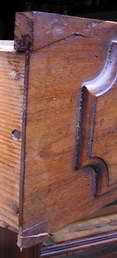breaks when the drawer
It can happen that the drawer of a mobile does not open more good that you necks at the corners by loosening the seal of plywood to the bottom so that it exits from the guide. Here is how to resolve these problems. In the first case, it is necessary first of all to discover the point of the clutch of the drawer with the mobile.
to do what you repeatedly passes a pencil to Punta Grossa over, under and on the flanks of the edges of the drawer. It then returns to the place and you slide; the sign of the pencil disappears in the point in which it occurred the hitch. Just then wipe the part with sandpaper, before a medium grit then fine grain, or with a Lima, and then review the entire sanded zone with the wet soap or with the paraffin. With this simple operation the drawer back to slide as before (and maybe even better).
If the side rails on which the drawer rests or slips are worn or have fallen for wear, causing an abnormal movement of the drawer itself, just piallarli slightly or pass them with a lima coarse and then paste on the scraped strips of wood of sufficient thickness to compensate for both the ruined, is that removed with the filings. Before putting the drawer to place we must let the adhesive dry.

When instead the corners of the drawer, joined together with an interlocking at mortise-tenon or wedges (round pins) or at an angle open, we must restore the interlocking to restore the tray to its original form. After fully opening the joint it is lima wood to remove only the layer of glue old (which no longer holds) and put a correct dose of glue new, matching perfectly the two pieces. At this point just wait that glue is dry to put back the drawer.
however it may happen that the interlocking has become loose. If the seam is with wedges (round pins), just Enlarge the diameter of the holes in which are housed and sistemarne of new of greater diameter. But if this is another type of joint, which now no longer be sustained, is useless any reinforcing element, all that remains is to shim it or rebuild it entirely. For the joint to angle the job is easier because it is removed with a rasp a millimeter of wood from one of the faces, paste over a thickness of the same wood of a couple of millimeters and leave to dry the glue.
Done this, it operates on the thickness again, returning the interlocking to measure and then arranging to bonding of the two parties.
In the more complex case of an interlocking coupling to mortise-tenon we must widen the mortise old, insert (glued) a piece of hard wood suitably shaped that fills completely, which must penetrate with a certain effort. Once the glue has taken, we practice in the piece of wood, inserted in the old mortise, a new housing, slightly narrower than the previous one. Thus reduces the tenon to the dimensions of the new mortise, glue the two parts, they mate and expects that the glue becomes dry.
This new interlock will be solid and resistant. Of course, before restoring definitively the joints should be put in place in the special lanes on the bottom of the drawer, so that the finished work is perfectly housed. If the plywood is deformed and is wider than the need to replace it with a new one.